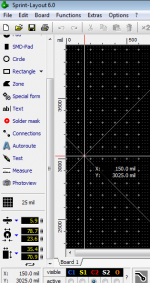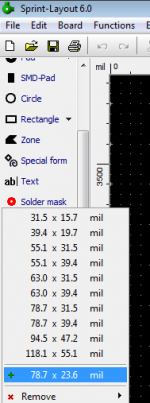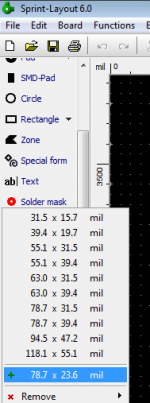Is it something like this you are after? It says 'Metric ONLY'. https://www.amazon.co.uk/METRIC-Moore-Wright-Engineers-Rules/dp/B00OY575H8
Thanks but I have one of those in 150mm version. What I haven't found yet is a tape measure or 1m ruler. I suspect i could google one and find it at great cost but none is available of the shelf.
"I wonder who would use Mils these days" 
Would, say, a Million PCB designers qualify?
Notice units used for *everything*, from track width, pad diameter, coordinates, board size, etc.
Would, say, a Million PCB designers qualify?
Notice units used for *everything*, from track width, pad diameter, coordinates, board size, etc.
Attachments
Would, say, a Million PCB designers qualify?
Notice units used for *everything*, from track width, pad diameter, coordinates, board size, etc.
You can also set the base units to millimeters if you want. So maybe a million PCB designers are actually using mm's.
jeff
Mils is still very common when measuring moisture membranes and vapour retarder thickness for materials made in NA. Outside of that mm's are most common.
As I recall, you're a carpenter, right?
Around here those guys, and the plumbers as well, are really getting a raw deal these days.
They still get their raw materials in Imperial, but their drawings are 100% metric.
Back when I studied, we would still get the occasional imperial drawing, but the last one I recall is years ago by now, and that was from the airforce, who are in bed with the U.S. anyway.
Magura
At least it wasn't hyperbolic functions and integral tables... 
Here I spent all those years memorizing tables of logarithms...
I've done a fair amount of PCB layout lately and generally use the mils setting in my tools. (For some reason I find mm harder to use for this purpose - guess I am not calibrated.)
I have a basic machine shop as well (I'm terrible at it) and there too I use mils.
As Cal pointed out lots of barrier materials are specified in mils here in NA.
For science and engineering work outside of PCB layout I mostly use SI units.
In home life it is a mix of both, at the gas station always U.S. gallons. (No longer sold by the liter here, but commonly so in Quebec Province and Montreal the only foreign territory I visit on a regular basis.) Temperature in °C or °F for domestic, °F is meaningless to me for thermal calculations.. LOL
I have a basic machine shop as well (I'm terrible at it) and there too I use mils.
As Cal pointed out lots of barrier materials are specified in mils here in NA.
For science and engineering work outside of PCB layout I mostly use SI units.
In home life it is a mix of both, at the gas station always U.S. gallons. (No longer sold by the liter here, but commonly so in Quebec Province and Montreal the only foreign territory I visit on a regular basis.) Temperature in °C or °F for domestic, °F is meaningless to me for thermal calculations.. LOL
I'm still trying to get my brain around how 0.03937 can be more accurate and easier to remember than 25.4...
Agree. 25.4 is Legally Exact. (the Old Inch was not quite 25.4mm, but we could not agree what it was, so 25.4 was defined by fiat.)
1/25.4 is at least 0.039 370 078 740 157 480 314 960 629 921 259 842 519 685 ... ...
.... ah, it repeats "039 370 078 740 157 480 314 960 629 921 259 842 519 685" forever. Only 42 digits to remember, compared to three "25.4" on the flip-side.
Last edited:
I use 25.4mm to an inch in my PCBCAD software.Agree. 25.4 is Legally Exact. (the Old Inch was not quite 25.4mm, but we could not agree what it was, so 25.4 was defined by fiat.)
The software often doubles up on metric and imperial when making foot prints. Accumulation of errors can be a real nuisance so I now don't add the next pad to the previous pad position as the previous pad position is rounded up/down.
I now keep a number of how many pads are being used in a row and that is multiplied by original pad distance so no accuracy is lost.
Where is NA?
Remember, I'm American...
I am also American, so what?
Saying unqualified "American" is not precise enough, since America is 14000 km end to end including some 35 Nations.
Maybe you are a citizen of the Country called "United States OF America"?
Okay- I was referring to the old joke- What do you call someone who speaks 3 languages? Trilingual. What do you call someone who speaks two languages? Bilingual. What do you call someone who speaks 1 language? American.
NA= North America.
Play the song- North American Scum, by LCD SoundSystem
lcd soundsystem north america - Yahoo Video Search Results
NA= North America.
Play the song- North American Scum, by LCD SoundSystem
lcd soundsystem north america - Yahoo Video Search Results
When I use pi I am almost always doing algebra so it stays as pi. On those occasions when I need a numerical value I will be using my old Casio fx-570 calculator which has a pi key and gives the value 3.141592654 -whether this is a true decimal representation of whatever format is used internally I don't know. The number I remember is 3.14159.takitaj said:What number does everyone use for pi?
I could never fully understand why it matters that pi is not only irrational but also transcendental. Then one day I was doing some algebra with lots of powers of pi and realised that I could equate coefficients on the left and right of the equation because pi behaves a bit like x, except that pi is fixed and x can vary. In algebra you have to match x with x, x^2 with x^2 etc. because you want your equation to be true for all values of x. When using pi the transcendental property means that you cannot balance pi against pi^2, assuming that the coefficients do not contain pi. A mathematician might be able to poke holes in this argument, but it is good enough for a physicist.
I sometimes use the rational expression 22/7 as an of estimate of pi. It's only accurate to a couple of decimal places, but good enough for a rough pencil & paper calculation.I could never fully understand why it matters that pi is not only irrational but also transcendental.
The big question is - where do you weigh a pi?
Doesn't it seem funny that the English converted to the metric system years ago and the USA still uses the English system?
Not so much pedantic or political as accurate:
the BRITISH (or the UK) converted to metric, the USA uses the IMPERIAL system. If England had converted then Scotland, Wales, Northern Ireland would still be using yards, feet and inches.
I've just looked out the triangular (in cross section) ruler, calibrated in inches, with full size, 3/4, 1/2, 3/8, 1/4 and 1/8 scales which I have kept since my days in a drawing office in about 1965.
2.54 is the real magic number for us here in Canada as we use inches and cm for the most part.
Sometimes makes me think it's a govt. plot to force us buy all tools in both systems. Good for the economy.
Even so, you always miss exactly the one tool that fits the d*mned part. Or always pick the wrong tool first. The weight scale is always set to the wrong units. You always get to the wrong side of the ruler.
The big question is - where do you weigh a pi?
Somewhere over the rainbow?
- Status
- This old topic is closed. If you want to reopen this topic, contact a moderator using the "Report Post" button.
- Home
- General Interest
- Everything Else
- Convert mm to inches - easy to remember!!


